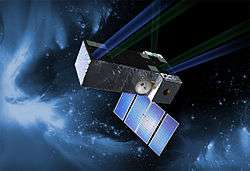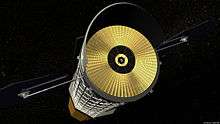List of proposed space observatories
List of proposed space observatories: examples of past and present space observatory plans, concepts, and proposals. For observatories in orbit, List of space telescopes. Unlike that list, this list includes concept and proposals that were not and in all likelihood will not ever be launched as they may have been cancelled or were only ever proposals.
Active in this list means it is still under consideration for development, not that it is in orbit
Legend
- Active
- Other
- Merged, Cancelled, Superseded
Additional examples

.
- Adithya
- Advanced Telescope for High Energy Astrophysics (ATHENA)
- Big Bang Observer
- CHEOPS (selected for launch)
- DECIGO
- EChO
- ExoplanetSat[20]
- Fast INfrared Exoplanet Spectroscopy Survey Explorer (FINESSE)
- Gravity and Extreme Magnetism (GEMS)
- Near Earth Object Camera (NEOcam)
- NICER (selected for launch)
- PLATO (selected for launch)
- PEGASE
- SAFIR
- Spektr-RG
- Space Infrared Telescope for Cosmology and Astrophysics (SPICA)
- Transiting Exoplanet Survey Satellite (TESS)
- Telescope for Habitable Exoplanets and Interstellar/Intergalactic Astronomy (THEIA)
- LOFT
- Planetary Dynamics Explorer[21]
- ZEBRA, Zodiacal dust, Extragalactic Background and Reionization Apparatus [22] A small infrared observatory sent out to 10 AU by NASA[23]
- Whipple, proposed transit telescope for KBO and Oort objects
Design studies
Various proposals or concepts for high-energy light observatories:[24]
- AdEPT: Advanced Energetic Pair Telescope: pair production telescope concept for gamma-ray polarimetry
- APT: Advanced Pair Telescope
- AEGIS: Astrophysics Experiment for Grating and Imaging Spectroscopy, soft X-ray spectrometer.
- Arcus, X-ray spectrometer concept for International Space Station
- ASCOT: Advanced Scintillator Compton Telescope
- AXSIO: Advanced X-ray Spectroscopic Imaging Observatory
- AXTAR: Advanced X-Ray Timing Array, X-ray timing mission
- BEST: Black Hole Evolution and Space-Time Observatory (include deep hard X-ray imaging (5 - 70 keV))
- Black Hole Finder
- CASTER: Coded Aperture Survey Telescope for Energetic Radiation
- EXIST: Energetic X-Ray Imaging Survey Telescope
- BHI: Black Hole Imager
- EPE: Extreme Physics Explorer
- EREXS: Epoch of Reionization Energetic X-ray Survey
- EXIST: Energetic X-ray Imaging Survey Telescope
- Gen-X: The Generation X-Ray Mission
- HEX-P: High-Energy X-ray Probe
- IXPE: Imaging X-ray Polarimetry Explorer
- ISS-Lobster
- Pharos
- PRAXyS: Polarimetry of Relativistic X-ray Sources
- SMART-X: Square Meter, Arcsecond Resolution X-ray Telescope
- SAHARA: Spectral Analysis with High Angular Resolution Astronomy
- WhimEx: Warm-Hot Inter-Galactic Medium Explorer
- WFXIS: Wide-Field X-ray Imaging Spectrometer
- WFXT: Wide-Field X-ray Telescope
- Xenia: a Probe of Cosmic Chemical Evolution
- X-Ray Surveyor
- A-STAR: All-Sky Transient Astrophysics Explorer
- Athena, an X-ray observatory
- DAMPE: Dark Matter Particle Explorer
- EDGE: Explorer of Diffuse emission and Gamma ray burst Explosions
- GRAVITAS: General Relativistic Astrophysics Via Timing and Spectroscopy
- LOFT: Large Observatory For X-ray Timing
- MIRAX: Monitor e Imageador de Raios X
- NHXM: New Hard X-ray Mission
- PheniX, focussing X-ray telescope concept
- Tsubame, micro-satellite for X-ray polarimetry
- XIPE: the X-ray Imaging Polarimetry Explorer (ESA)
Future
For launch in the 2030s NASA is evaluating four possible designs: the Far-Infrared Surveyor, X-Ray Surveyor, Habitable-Exoplanet Imaging Mission (HabEx), and Large Ultraviolet-Optical-Infrared Surveyor (LUVOIR).[25]
Gallery
 Artist's impression of the Laser Interferometer Space Antenna
Artist's impression of the Laser Interferometer Space Antenna Artist's impression of the SIM Lite Astrometric Observatory
Artist's impression of the SIM Lite Astrometric Observatory NASA conception of IXO
NASA conception of IXO
References
- ↑ "Advanced Technology Large-Aperture Space Telescope". Space Telescope Science Institute. Retrieved 2010-10-08.
- ↑ "KEUS - The X-Ray Evolving Universe Spectroscopy Mission". ESA. Retrieved 2008-02-28.
- ↑ "Official NASA IXO Home Page". NASA. Retrieved 2008-02-28.
- ↑ "SIM Lite JPL". NASA. Retrieved 2009-03-19.
- ↑ "ESA Science & Technology: Darwin". ESA. Retrieved 2008-02-28.
- ↑ "Planet Quest: Missions - Terrestrial Planet Finder". NASA. Retrieved 2008-03-03.
- ↑ "Dark Universe Observatory". Sonoma State University. Retrieved 2008-02-29.
- ↑ "Dark Universe Observatory - About the Launch Vehicle and Orbit". Sonoma State University. Retrieved 2008-02-29.
- ↑ "Destiny JDEM Mission Public Page". National Optical Astronomy Observatory. Retrieved 2008-02-28.
- ↑ "$1.6 Billion Telescope Would Search Alien Planets and Probe Dark Energy". SPACE. Retrieved 2010-10-09.
- ↑ "Astro2010 Report Release Presentation" (PDF). NASA. Retrieved 2010-10-09.
- ↑ "NASA - NSSD - Spacecraft - Trajectory Details (Astromag FF)". NASA. Retrieved 2008-02-27.
- ↑ "NASA - NSSDC - Spacecraft - Details (Astromag-F)". NASA. Retrieved 2008-02-27.
- ↑ "VSOP-2 project". JAXA. Retrieved 2008-02-28.
- ↑ "EXCEDE Home Page". University of Arizona. Retrieved 2012-02-23.
- ↑ "EXCEDE the Search for Planets". Astrobiology magazine. Retrieved 2012-02-23.
- ↑ "ESA Science & Technology: LISA". ESA. Retrieved 2008-02-27.
- ↑ WSO-UV
- ↑ SAFIR
- ↑ Gunter's Space Page - ExoplanetSat
- ↑ M. Wong , et al. - A Dedicated Space Observatory for Time-domain Solar System Science
- ↑ Universe Today - NASA Considers Sending a Telescope to Outer Solar System by Bruce Dorminey on December 19, 2011
- ↑ ZEBRA
- ↑
- ↑ Scoles, Sarah. "NASA Considers Its Next Flagship Space Telescope". Scientific American. Retrieved 2016-03-31.
External links
- Video (86:49) - "Search for Life in the Universe" - NASA (July 14, 2014).